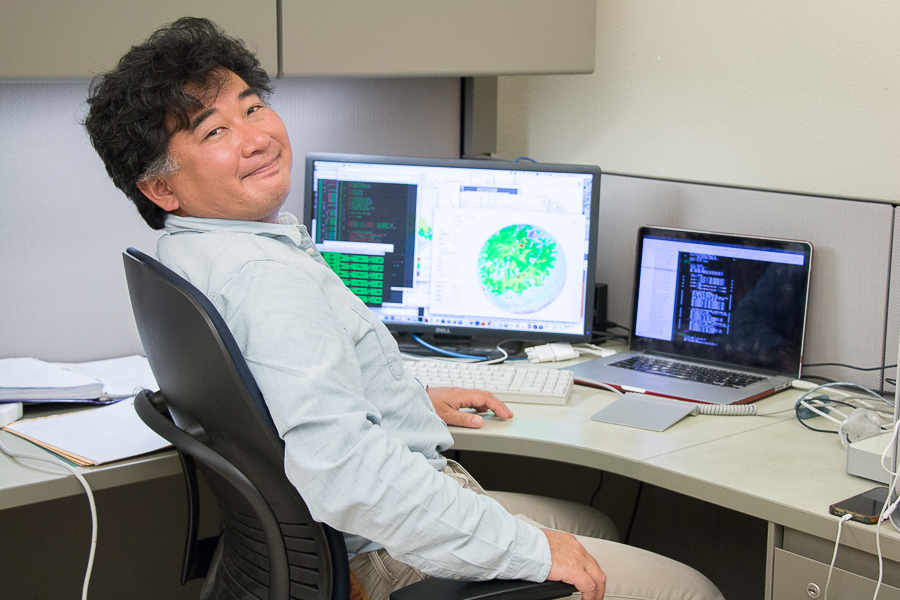
Working group involves collaborators from universities across the country
Imagine that one day, the electrical grids covering the earth malfunctioned. All technology powered by electricity went out, and it was impossible to access news sources and social media to find out what happened. What could cause this?
This question and others are being tackled by Computation Infrastructure for Geodynamics. The CIG, based in UC Davis, is home to a variety of working groups, one of which is the Geodynamo working group. This group is headed by Jonathan Aurnou, a professor of earth, planetary and space sciences at UCLA. The group was granted hours over a period of three years on the Mira supercomputer from the U.S. Department of Energy to run its computer simulations. The Geodynamo working group consists of researchers from UCLA, UC Berkeley, UC Santa Cruz, UC Davis, the University of Colorado, Boulder, the University of Alberta, and Johns Hopkins University.
The research focuses on the geodynamo, the self-sustaining process by which the earth’s liquid core maintains its magnetic field to protect the earth’s surface. Since a planet’s core is thousands of miles below its surface, researchers create simulations based on their observations to test different hypotheses as to what exactly is at the core of the earth. The supercomputer access expedites the information gathering by dedicating hundreds of thousands of processing cores to run simulations.
“That’s why we have to model such [a] process from the simulation results,” said Hiroaki Matsui, an associate professional researcher at CIG. “That’s also why we need big simulations and a lot of information.”
Though the magnetic field is not detectable by the human eye, it is important in daily life. It protects the earth from cosmic particles that are in constant contact with the planet, according to Bruce Buffett, a professor of earth and planetary science at UC Berkeley.
However, the magnetic field does sometimes reverse polarity, on average around four times during a 1 million year span. This means the north and south poles flip, which, in theory, would weaken the protection of the magnetic field, as well as affect the way society functions.
“Things like electrical grids would probably start malfunctioning — cell phones, satellites, things like that,” Buffett said. “Understanding what the magnetic field is doing, and the nature of the protection we get from it is, in some ways, a pretty important societal motivator. There’s no evidence that there are extinctions or anything, but from the point of view of a society that developed and relies on electrical infrastructure, it’d be a huge change to the way that we live.”
Buffett stated that the last polarity reversal was about 780,000 years ago, meaning the earth is likely overdue for another magnetic field reversal.
“The good news is we’d probably have lots of warning,” Buffett said. “Presumably with these sorts of models and a little more sophistication, we might be able to make forecasts of whether there’s reversal coming or not.”
According to Matsui, there isn’t a consensus on whether or not earth’s magnetic field helps foster life. Geomagnetic fields have many unknowns, but new information is coming in through seismology observations and other related research.
“All of the scientific software we develop at CIG is open source, and a big part of our mission is teaching students to develop and use high-quality scientific software in their own research,” said Louise Kellogg, a professor of earth and planetary sciences at UC Davis, as well as the director of the CIG, in an email interview. “Our students go on to a variety of careers in industry, government, research, and teaching, and they bring with them the technical expertise they learn here.”
Matsui’s code to model magnetic field and core simulations, called Calypso, was first developed when he was an undergraduate in Japan about 20 years ago. That code is still being used and updated today by Matsui. It can be downloaded by anyone, though people without access to supercomputers are limited in what simulations can be run. The Calypso code is being used in conjunction with Nick Featherstone’s Rayleigh, which will most likely be distributed by CIG in the near future.
“UC Davis is the headquarters of the Computational Infrastructure for Geodynamics, which is funded by the National Science Foundation to advance research using high performance computing for problems like the geodynamo, plate tectonics, and earthquakes,” Kellogg said. “These computer runs on the world’s 6th fastest computer were made through an allocation of computing time on the Argonne Leadership Computing Facility at Argonne National Laboratory. These are essentially a large experiment, generating very large datasets, and the team will be analyzing the results over the next year.”
Matsui is excited to get started on the next phase of research, which includes collecting more data and fine-tuning the results through the use of the supercomputer.
“If we know the solution and we’re going the right direction and everything goes well [from the start], it sounds kind of boring,” Matsui said. “[Research] not going well is pretty fun. But fatal results is almost impossible to make into a paper — who would want to read a paper on something not going well? But, honestly, such fatal results, yes, that teaches me lots of stuff.”
Written by: Jack Carrillo Concordia — science@theaggie.org




